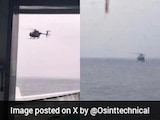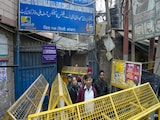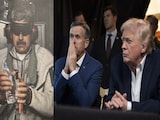Boeing CEO Jim McNerney arrives for a signing ceremony
Le Bourget, France:
Boeing launched a bigger version of its Dreamliner plane at the Paris Air Show on Tuesday with over 100 orders worth about $30 billion and a clear message -- after a run of technical blows, the US firm is back on track.
The announcement came on the second day of the world's biggest air show, with competition between Boeing and its arch-rival Airbus heating up as the two giants vie for the spotlight, and smaller competitors make their presence felt.
Airbus followed up huge orders on the first day on Monday with a deal to sell 135 planes to EasyJet.
"Boeing today officially launches the 787-10," Boeing head Jim McNerney told reporters, with commitments to buy the new aircraft from United Airlines, Singapore Airlines, British Airways, and leasing firms ALC and GECAS.
The new-generation 787-10 is bigger than its two brothers in the fuel-efficient Dreamliner family, and Singapore Airlines and ALC were its two biggest customers on Tuesday, with 30 orders each.
United committed to buying 20 planes while British Airways will get 12 and GECAS 10.
Boeing did not say how much the deals were worth, but a 787-10 is worth $290 million at catalogue prices.
That would mean the contracts were worth $29.6 billion, although hard negotiation usually results in big discounts on list prices in the airline industry.
The announcement puts Boeing firmly back in the running after a slew of recent technical problems forced the grounding of the entire Dreamliner fleet worldwide for three months in a huge blow to the US firm.
Randy Tinseth, vice president of marketing at Boeing's commercial planes division, said last week that the growth in traffic was being met by more flights to more places, "rather than dramatically larger and larger aircraft", in a dig at Airbus's A380 superjumbo.
"It really gets to the heart of competition -- to be succesful, what you need to do is give the type of service that passengers want and what we all want is more frequent non-stop service.
"This is why we brought the 787 to the market place."
Undeterred, Airbus has got off to a roaring start at the air show -- though most of its orders so far arise from the medium-haul market, which it already dominates.
All in all, if catalogue prices are used as a barometer and only firm orders taken into account, Boeing took the lead from Airbus on the second day with orders worth $34.2 billion so far, compared to $31.5 billion for the European firm.
-- Regional transport market going strong --
Low-cost airline easyJet announced a deal to buy 135 of the Airbus single-aisle A320 passenger planes -- one of the firm's most popular and profitable models -- including 100 of new generation fuel-efficient neo aircraft.
But Airbus is seeking to unseat Boeing in the more lucrative long-haul segment with its own next-generation A350 plane, which flew for the first time on Friday in a curtain raiser for the show
The aircraft -- which like the Dreamliner makes extensive use of lighter, carbon-based composite materials that reduce fuel consumption -- will seek to compete with the 787 as well as Boeing's older 777 model.
So far, though, there have been no new orders for the A350 at the air show.
Other smaller competitors in regional transport markets have also made a mark, with ATR -- a joint venture between European aerospace giant EADS and Italy's Finmeccanica -- announcing a big order.
Leasing firm Nordic Aviation Capital (NAC) signed up for 35 ATR-600 aircraft built by the firm, with an option on 55 in a deal worth $2.1 billion, ATR said.
NAC has a fleet of slightly more than 100 ATR regional-route aircraft and is the biggest operator in the world of the propellor-driven planes, ATR said.
Brazil's Embraer has also come up trumps with the launch of a new family of regional jets and dozens of orders.
This is a sign of an expected future trend of competition from manufacturers in emerging markets which are expected to generate much of the growth of passenger traffic.
The announcement came on the second day of the world's biggest air show, with competition between Boeing and its arch-rival Airbus heating up as the two giants vie for the spotlight, and smaller competitors make their presence felt.
Airbus followed up huge orders on the first day on Monday with a deal to sell 135 planes to EasyJet.
"Boeing today officially launches the 787-10," Boeing head Jim McNerney told reporters, with commitments to buy the new aircraft from United Airlines, Singapore Airlines, British Airways, and leasing firms ALC and GECAS.
The new-generation 787-10 is bigger than its two brothers in the fuel-efficient Dreamliner family, and Singapore Airlines and ALC were its two biggest customers on Tuesday, with 30 orders each.
United committed to buying 20 planes while British Airways will get 12 and GECAS 10.
Boeing did not say how much the deals were worth, but a 787-10 is worth $290 million at catalogue prices.
That would mean the contracts were worth $29.6 billion, although hard negotiation usually results in big discounts on list prices in the airline industry.
The announcement puts Boeing firmly back in the running after a slew of recent technical problems forced the grounding of the entire Dreamliner fleet worldwide for three months in a huge blow to the US firm.
Randy Tinseth, vice president of marketing at Boeing's commercial planes division, said last week that the growth in traffic was being met by more flights to more places, "rather than dramatically larger and larger aircraft", in a dig at Airbus's A380 superjumbo.
"It really gets to the heart of competition -- to be succesful, what you need to do is give the type of service that passengers want and what we all want is more frequent non-stop service.
"This is why we brought the 787 to the market place."
Undeterred, Airbus has got off to a roaring start at the air show -- though most of its orders so far arise from the medium-haul market, which it already dominates.
All in all, if catalogue prices are used as a barometer and only firm orders taken into account, Boeing took the lead from Airbus on the second day with orders worth $34.2 billion so far, compared to $31.5 billion for the European firm.
-- Regional transport market going strong --
Low-cost airline easyJet announced a deal to buy 135 of the Airbus single-aisle A320 passenger planes -- one of the firm's most popular and profitable models -- including 100 of new generation fuel-efficient neo aircraft.
But Airbus is seeking to unseat Boeing in the more lucrative long-haul segment with its own next-generation A350 plane, which flew for the first time on Friday in a curtain raiser for the show
The aircraft -- which like the Dreamliner makes extensive use of lighter, carbon-based composite materials that reduce fuel consumption -- will seek to compete with the 787 as well as Boeing's older 777 model.
So far, though, there have been no new orders for the A350 at the air show.
Other smaller competitors in regional transport markets have also made a mark, with ATR -- a joint venture between European aerospace giant EADS and Italy's Finmeccanica -- announcing a big order.
Leasing firm Nordic Aviation Capital (NAC) signed up for 35 ATR-600 aircraft built by the firm, with an option on 55 in a deal worth $2.1 billion, ATR said.
NAC has a fleet of slightly more than 100 ATR regional-route aircraft and is the biggest operator in the world of the propellor-driven planes, ATR said.
Brazil's Embraer has also come up trumps with the launch of a new family of regional jets and dozens of orders.
This is a sign of an expected future trend of competition from manufacturers in emerging markets which are expected to generate much of the growth of passenger traffic.















